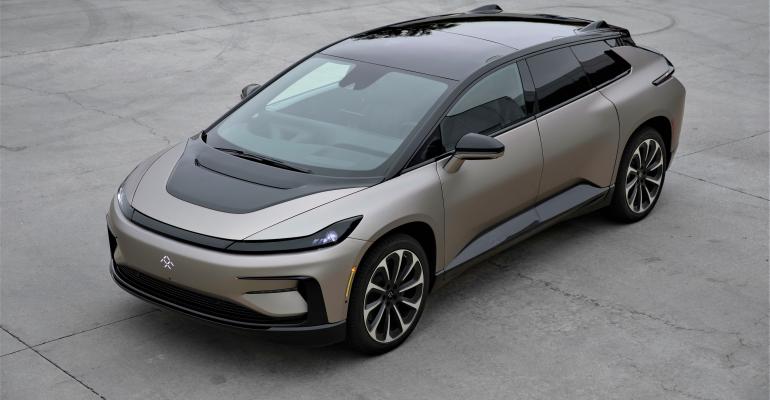Faraday Future, the troubled electric-car company that’s been talking about taking on Tesla for years, might actually live to see more than just another day. New leadership, fresh investment, a revised strategy and bridge financing against company assets have staved off the vultures…for now.
But the clock is ticking. Loudly.
Yueting Jia, one of Faraday Future’s founders, relinquished his grip on company power and moved into a technology-focused role better aligned with his background as an internet entrepreneur. That change makes way for new CEO Carsten Breitfeld (below, left), a 25-year automotive industry veteran, to bring sharper focus to the step-by-step execution Faraday Future requires.
Spend a day talking with Breitfeld and company executives at the automaker’s Gardena, CA, headquarters and it’s clear they know time is running out. Faraday’s current stash of $15 million in operational cash and a potential line of credit up to $200 million, including a vendor trust of $150 million, won’t last forever.
But Faraday Future has slimmed itself down to approximately 600 employees evenly split between California and China. Potential investors are, according to Breitfeld, returning to the table to talk. And passion for the project still runs deep among those working to bring the company’s products to life.
Revised product timelines project the start of FF 91 production in September 2020 at the company’s Hanford, CA, assembly plant, a refurbished former Pirelli tire factory capable of building 10,000 vehicles annually.
 Faraday’s North Las Vegas, NV, production site was scuttled when the company realized it didn’t need the planned amount of space and will be sold, according to Mark Cuyler, vice president-manufacturing, advanced engineering and operations.
Faraday’s North Las Vegas, NV, production site was scuttled when the company realized it didn’t need the planned amount of space and will be sold, according to Mark Cuyler, vice president-manufacturing, advanced engineering and operations.
A flagship product to demonstrate Faraday Future’s potential, the FF 91 CUV boasts a 3-motor electric all-wheel-drive propulsion system making 1,050 hp. According to the company, acceleration to 60 mph (97 km/h) takes less than three seconds, and the EV’s stated range is 378 miles (609 km). The 130-kWh battery pack is compatible with 200-kW fast chargers, providing an 80% recharge in an estimated 20 minutes.
A short ride in a pre-production FF 91 demonstrates the car’s effortless thrust. High-tech screens are everywhere, and the seats are comfortable. Wind noise and a somewhat rough ride are likely byproducts of the car’s hand-built, early-stage status.
Glancing behind the individual rear seats, which fully recline like first-class airline accommodations (below, left), I asked our driver how much trunk space the FF 91 offers. “A couple of suitcases,” is the reply. “Carry-ons,” he clarifies.
Perhaps the new FF 81 will improve upon this meager utility. Smaller than the FF 91, and expected to cost half the approximate $175,000 price of the flagship, the FF 81 applies design cues similar to a vehicle the size of a Tesla Model S. It is slated for production in early 2022.
The FF 81 and FF 91 are built on a Variable Platform Architecture (VPA). Faraday Future’s next vehicle, the FF 71, will adopt what the company calls a VPA 2.0 platform. A Tesla Model 3 competitor, the FF 71 is set to debut at the 2021 CES in Las Vegas.
 Engineered for shared-mobility solutions, the more affordable VPA 2.0 architecture will allow Faraday to scale its business in the direction the company believes will transform it into a transportation disruptor.
Engineered for shared-mobility solutions, the more affordable VPA 2.0 architecture will allow Faraday to scale its business in the direction the company believes will transform it into a transportation disruptor.
Breitfeld says EV architectures will become a commodity: battery packs under the cabin floor, electric motors at both ends powering four wheels. The differentiator will be the interior and technology user experience, in much the same way custom coachbuilders of the early 1900s bought rolling chassis to tailor for specific customer preferences.
Building its vehicles using what it calls an open and shared intelligent mobility digital ecosystem, Faraday Future expects to profit by selling its engineering and technology to other companies, and by selling customers digital products and services.
Matthias Aydt, senior vice president-product execution, cites the example of 4-wheel steering, which can improve vehicle handling and tighten the turning radius for improved maneuverability. The hardware, already offered in certain production vehicles, will exist in a Faraday Future model, but the customer will need to pay extra to activate it.
Breitfeld also outlines a future where FF models are both privately owned and serve as ride-share vehicles that automatically tailor themselves to a fare’s preferences. The goal? Increase daily vehicle use from today’s current 5% to 70% by keeping fleets of shared FF 71s rolling.
Executives characterize Faraday Future as a technology company, not a car company. “This is not a car,” Shyam Sundar, global head of product, says of the FF 91. “This is a consumer device on wheels.”
If Faraday has a future, investors will need to warm up to Breitfeld and buy into the planned profitability of what Aydt calls the membership and service mobility ecosystem. Otherwise, it will be nothing more than a futuristically styled commodity.






